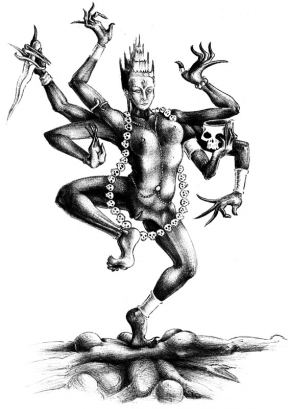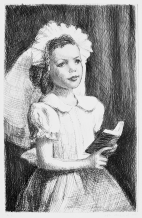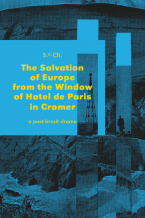| Umělec magazine 2010/1 >> Mad Meg | List of all editions. | ||||||||||||
|
|||||||||||||
Mad MegUmělec magazine 2010/101.01.2010 Noelle Papay | profile | en cs de |
|||||||||||||
|
Carrying a basket full of pens, pencils, paper, and ink, Mad Meg would go on walks—and be drawn into the depths of the earth, buried among putrefied human bodies, pursued by insect men and turbid animals. And she relates all this to us through her drawings of what she’d seen...
Harmonious and nightmarish, her universe is a reflection of our time, our society. Her Tableaux de Digestions, inspired by the works of the great masters art history—Rembrandt, Rubens, Jan Van Eyck, Filippo Lippi, Peter Brueghel, Hieronymus Bosch—engulf us with the putrid stench of hell where graces become ghouls, and anatomy gives way to pornography… In les trois garces, the artist incorporates da Vinci’s Last Supper, Grunewald’s Issenheim Altarpiece, Goya’s Collosus, de Zurbaran’s La Santa Faz, and de Andrade’s Louvre along with a variety of photographic and religious references that catch our attention and leave us a lingering sense in our eyes and leave us a sense of déjà vu—or a bitter taste. The artist ruminates on the various references, scrutinizing them in search of the most subtle of details. By pushing hard with this technique, she has been carefully composing her ideas since 2001 in the form of sketchbooks that she calls carnets de digestion. These are 450 pages spread over twelve notebooks infused with drawings and texts, depicting reactions to contemporary political, economic and social news, all working towards the future composition of her tableaux de digestions. Le Jardin des Délices is a sort of synthesis of these exercise drawings: a Dantesque vision of our world, nourished by the vices of our society raped, where the weakest are tortured and crushed by a culture of repression and machismo. In addition to her tableaux de digestion, Mad Meg has been extending her critiques and soothing her exacerbation, since 2004 with a series of seven cartoons that she entitled, Factuals Tales. Influenced by French and international news and politics, Mad Meg is engaged, relating it all to us with a ferocity of vision and considerable humor. Far from fairy tales with their happy endings, the artist confronts her own childhood stories, yet adjusts their course. Here the relationship to the marvellous ceases to exist; Mad Meg breaths life into her characters, and she lets them die—just like in real life. The narrative thread is, in contexts of war, poverty, cruelty, political abuse wherein heroes, that in fairy tales are thought of as the enemies of the people, supplant the place of more pleasant people, and wreak havoc upon any sign of hope. With lots to say, Mad Meg speaks through her images. She expresses herself through pictures as much as they speak for themselves. Rather than attempt any psychological portrait of the artist, I shall take a step backwards in search of the reasons, the events that have plunged her into this beautiful, dark world. Both her parents studied art, and Margot, alias Mad Meg as an artist, spent her childhood sketching and admiring the paintings of Hieronymus Bosch in her parents’ art books. Thus, her identity was developed by an incessant calling to illustration that fills the imagination, and a small girl’s boredom. Her recipe for happiness was simple: a pencil and a sheet of paper were left overflowing with her imagination and creativity. In this way, Margot pursued her ambition taking art lessons, and after a brief stint at Les Beaux-Arts de Paris (where she discovered Modern and contemporary art for the first time), she devoted herself entirely to drawing. The zoo, botanical gardens and anatomical museums have become her playground: animals, plants, skeletons and bodies are her models and build a universe infused with curiosity. In an instinctual way, much like human necessities such as eating, drinking and sleeping, Mad Meg would sketch daily, such that it became a natural effort. With this process, she began her own apprenticeship with her Carnets de Digestion similar to diary entries from 2001. Whereas some people express themselves by indulging in writing, Mad Meg communicates through her drawings, so as to better support her life. A philosophy that is in keeping with her own life’s rhythm: “Positive things are made to be experienced because they are more interesting to live than to draw.” Thinking that there is not often much to say about happy events, Mad Meg ponders her own life, her nightmares and unpleasant stories, and the rhythm of her life as an artist with periods of hyperactivity followed by emptiness—or she takes time out to “digest,” to ripen. This story she told me is illustrative of her working process: six years ago, she started an internet game called _Eve online_. So completely absorbed in it was she that she did nothing else for six months. And one day, she was rudely awakened and set out to make a great drawing. It is there that she began the series of Patriarchs and Tableaux de Digestion. She made use of the material for her Carnets de Digestion. In fact, what Mad Meg was really saying was that she’d spoken that night with someone who gave her good advice. Mad Meg’s work communicates with surprising emotion: a clear outcome, extremely dark but supported by a technical expertise of drawing enabling the viewer to simply succumb blissfully to illusion. A Little bit like death. “There is no point in being pessimistic, because the worst is always certain.” Drawings extract from Les Carnets de Digestion. ballpoint pen on paper 11 x 15 cm 482 pages Translated from French by William Hollister and Julie Le Belhomme (comics).
01.01.2010
Recommended articles
|
|||||||||||||
|
04.02.2020 10:17
Letošní 50. ročník Art Basel přilákal celkem 93 000 návštěvníků a sběratelů z 80 zemí světa. 290 prémiových galerií představilo umělecká díla od počátku 20. století až po současnost. Hlavní sektor přehlídky, tradičně v prvním patře výstavního prostoru, představil 232 předních galerií z celého světa nabízející umění nejvyšší kvality. Veletrh ukázal vzestupný trend prodeje prostřednictvím galerií jak soukromým sbírkám, tak i institucím. Kromě hlavního veletrhu stály za návštěvu i ty přidružené: Volta, Liste a Photo Basel, k tomu doprovodné programy a výstavy v místních institucích, které kvalitou daleko přesahují hranice města tj. Kunsthalle Basel, Kunstmuseum, Tinguely muzeum nebo Fondation Beyeler.
|









































 We Are Rising National Gallery For You! Go to Kyjov by Krásná Lípa no.37.
We Are Rising National Gallery For You! Go to Kyjov by Krásná Lípa no.37.
Comments
There are currently no comments.Add new comment